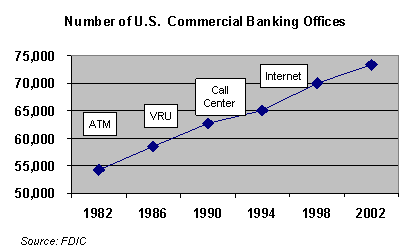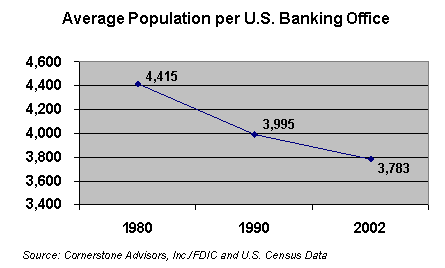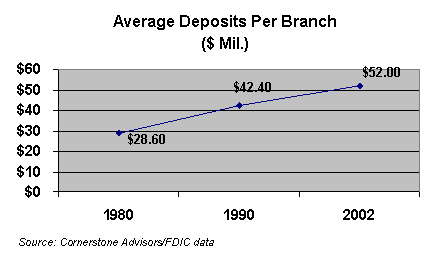
If there’s one thing I’ve learned in my 947 years in banking, it’s that new delivery channels never, ever reduce customer activity in the branches. In the past 20 years, our industry has added a national ATM network, deployed automated voice response systems, fired up 24/7 call centers and pumped Internet banking into nearly 30 million households. The result? Bank offices have actually grown from 50,000 to 75,000 in the same time period (see figure). When thrifts are included, the total number of branches jumps to nearly 87,000. In 1980, the average bank had 3.85 offices; today that number has jumped to 9.25.

Now, pick up a Wall Street Journal or USA Today and you’ll quickly find that building new branches is back in vogue. The ol’ bank branch is wicked cool these days. Check out these recent news excerpts:
Yup, it now feels like the great Oklahoma Run for slapping up brick and mortar. What a turnaround from the prehistoric label that branches were given in the “dot.com” days. I think we can give Vernon Hill, CEO of Commerce Bank in New Jersey, 100% of the credit for igniting the branch’s rebirth. As a long-time darling of Wall Street, Commerce has racked up some impressive numbers. In the past five years, the bank has gone from $4 billion in deposits to $16 billion. The company targets an aggressive 25% annual deposit growth rate without acquisitions. This year, Commerce will add 46 branches to the 243 it already has – talk about aggressive expansion! While this strategy has been a home run for Commerce, it clearly is not a business model that can go on forever. In fact, through the second quarter of this year, Commerce stock was down nearly 15% as investors began to more heavily scrutinize the massive costs of the company’s fast-paced branch buildup.

Now for the bad news: the Commerce “miracle” may be spurring too many copycats in our industry. One of my greatest fears is that our renewed love affair with brick and mortar will result in branch overcapacity. Could it happen? Sure. Certain statistics illustrate some warning signs on the horizon. From 1980 to December 2002, the average population per branch in the U.S. plummeted 15% from 4,415 to 3,783 (see figure).

These figures sound pretty scary, especially when one considers that there are thousands of new branches on the drawing board today. At the same time, the banking industry has continued to grow, and the average deposits per bank branch have increased handsomely since 1980 – from a measly $28 million to an impressive $52 million today. In addition, bank/thrift premises costs as a percentage of assets have dropped from .49% to .43% in the past 10 years.

In the 1990s, banks caught the M&A fever and many ended up destroying shareholder value. This decade, it’s important that we don’t experience a similar lapse of logic with branch growth. Make no mistake, I’m all for branching. But let’s make sure we approach this opportunity with some discipline. If your bank has big plans right now for branching, I beg you to follow GonzoBanker’s official six-point plan for successful delivery system growth:
#1: Do your homework on site selection.
Branch site selection is fast becoming an information-driven science, and banks need to be much more rational in how they approach new offices. (Note: the Chairman’s buddy owning a nearby piece of land is not a rational approach.) Demographic, competitive and sophisticated modeling information can be used to pick sites that match the strategic objectives of a particular branch. Small institutions looking for an affordable branch analysis tool should check out the ever-cerebral Steve Reider at bancography.com.
#2: Get creative (but not too cute) on branch design.
Good news: banks are beginning to experiment with branch designs that fall outside of the ol’ pillar, rope line, and mausoleum look. The most famous branch retailing experiment has been Washington Mutual‘s “Occasio” strategy, which basically tries to make branches look like a cross between Barnes & Noble and the Gap. There is no teller line, but rather a concierge type setup with roaming customer service employees who do not handle cash. WAMU’s gotten a lot of press, but frankly the Occasio layout turns me off. Call me a curmudgeon, but I like the fairness that a teller line provides. At the same time, WAMU knows how to make retail profitable and it has inspired bankers to think differently about modern-day branching.
#3: Stay flexible and watch the capital expenditures.
Since no one knows if these branch expansions will succeed or fail, many banks are trying to build escape hatches into their growth strategy. Some are leasing space instead of buying it. Build-to-lease options are also being considered. One of my associates at Cornerstone, Jeff Wagner, has begun encouraging banks to explore sale-leasebacks of their entire branch delivery systems in the years ahead.
#4: Recruit talent well before the ribbon cutting.
New branches are basically oversized ATMs unless an aggressive business development team is opening the doors every morning. Building a branch is the easy part; finding the right talent to grow that new store will be a bear. It is far more profitable to recruit the right franchise players in advance and then build a branch than it is to build a branch and start praying the sales team can be recruited.
#5: Prune and trim to help pay for the build.
Smart banks today are not just slapping up new branches. Rather, to pay for new offices, high performers are divesting out of certain markets, consolidating offices where it makes sense, appointing new managers at low performing locations and funneling more resources to the high performers. Managing branches should be just like managing any other asset portfolio. Buy here, sell here, cut your losses here, etc.
#6: Put teeth into branch profitability.
Remember the branch profitability reports? You know, those papers you use to place your jelly doughnut and coffee on each morning. Well Gonzo Mongers, it’s time to start paying attention to that poor analyst in the Finance department:
The opportunity cost of the capital being deployed to new branches is just too big to avoid hard-nosed profitability management.
Here’s one parting thought Gonzo readers. In our industry’s rabid enthusiasm to build more offices, we’ve all got to remember that additional branches don’t necessarily produce better service or competitive advantage. A slick modern office with lobotomized tellers and authority-neutered managers is a waste of shareholder money. The Los Angeles Times editorial page recently ran a cynical little column we should all take to heart:
“More branches are being built daily. More unattended teller slots. More places to stand in line on hard floors next to shiny poles and nifty smooth ropes like at the movies. And more jobs for tellers to have lunch breaks that precisely match yours…You often hear people say ‘I want to got to the bookstore’ or ‘I want to go to the movies.’ Think about it. Have you ever heard, ‘I want to go to the bank’?
“Maybe banks should ponder sprucing up customer service first before constructing thousands more impatience intensification parlors.”
Ouch. They’ve got a point.
-spw